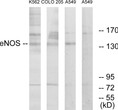| Host: | Rabbit |
| Applications: | WB/IHC/IF/ELISA |
| Reactivity: | Human/Mouse/Rat |
| Note: | STRICTLY FOR FURTHER SCIENTIFIC RESEARCH USE ONLY (RUO). MUST NOT TO BE USED IN DIAGNOSTIC OR THERAPEUTIC APPLICATIONS. |
| Short Description : | Rabbit polyclonal antibody anti-Nitric oxide synthase 3 (1145-1194) is suitable for use in Western Blot, Immunohistochemistry, Immunofluorescence and ELISA research applications. |
| Clonality : | Polyclonal |
| Conjugation: | Unconjugated |
| Isotype: | IgG |
| Formulation: | Liquid in PBS containing 50% Glycerol, 0.5% BSA and 0.02% Sodium Azide. |
| Purification: | The antibody was affinity-purified from rabbit antiserum by affinity-chromatography using epitope-specific immunogen. |
| Concentration: | 1 mg/mL |
| Dilution Range: | WB 1:500-2000IF 1:50-300IHC 1:50-300 |
| Storage Instruction: | Store at-20°C for up to 1 year from the date of receipt, and avoid repeat freeze-thaw cycles. |
| Gene Symbol: | NOS3 |
| Gene ID: | 4846 |
| Uniprot ID: | NOS3_HUMAN |
| Immunogen Region: | 1145-1194 |
| Specificity: | NOS3 Polyclonal Antibody detects endogenous levels of NOS3 protein. |
| Immunogen: | The antiserum was produced against synthesized peptide derived from human eNOS. AA range:1145-1194 |
| Tissue Specificity | Platelets, placenta, liver and kidney. |
| Post Translational Modifications | Phosphorylation by AMPK at Ser-1177 in the presence of Ca(2+)-calmodulin (CaM) activates activity. In absence of Ca(2+)-calmodulin, AMPK also phosphorylates Thr-495, resulting in inhibition of activity. Phosphorylation of Ser-114 by CDK5 reduces activity. |
| Function | Produces nitric oxide (NO) which is implicated in vascular smooth muscle relaxation through a cGMP-mediated signal transduction pathway. NO mediates vascular endothelial growth factor (VEGF)-induced angiogenesis in coronary vessels and promotes blood clotting through the activation of platelets. Isoform eNOS13C: Lacks eNOS activity, dominant-negative form that may down-regulate eNOS activity by forming heterodimers with isoform 1. |
| Protein Name | Nitric Oxide Synthase 3Constitutive NosCnosEc-NosNos Type IiiNosiiiNitric Oxide Synthase - EndothelialEndothelial NosEnos |
| Database Links | Reactome: R-HSA-1222556Reactome: R-HSA-1474151Reactome: R-HSA-203615Reactome: R-HSA-203641Reactome: R-HSA-203754Reactome: R-HSA-392154Reactome: R-HSA-5218920Reactome: R-HSA-9009391Reactome: R-HSA-9856530 |
| Cellular Localisation | Cell MembraneMembraneCaveolaCytoplasmCytoskeletonGolgi ApparatusSpecifically Associates With Actin Cytoskeleton In The G2 Phase Of The Cell CycleWhich Is Favored By Interaction With Nosip And Results In A Reduced Enzymatic Activity |
| Alternative Antibody Names | Anti-Nitric Oxide Synthase 3 antibodyAnti-Constitutive Nos antibodyAnti-Cnos antibodyAnti-Ec-Nos antibodyAnti-Nos Type Iii antibodyAnti-Nosiii antibodyAnti-Nitric Oxide Synthase - Endothelial antibodyAnti-Endothelial Nos antibodyAnti-Enos antibodyAnti-NOS3 antibody |
Information sourced from Uniprot.org




























